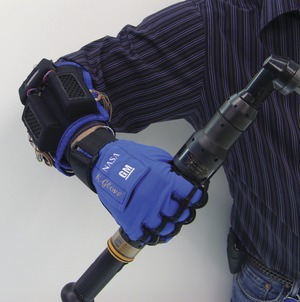
Construction workers of the future may be able to manipulate their heavy hand tools with a high-tech assist from a new robotic glove being developed jointly by General Motors and the National Aeronautics and Space Administration (NASA).
Officially called the Human Grasp Assist device (a.k.a., the "Robo-Glove" or "K-glove"), the device is designed to help alleviate the hand-muscle fatigue that astronauts and factory workers often experience from continuously gripping a tool for extended periods. Weighing just two pounds, the fabric-covered glove's sensors, actuators, and tendons mirror the nerves, muscles, and tendons in a human hand.
Initial tests of Robo-Glove prototypes indicate that a wearer can hold a grip longer and more comfortably, yet still possess a remarkable amount of hand dexterity—an important consideration for workers wearing bulky pressurized spacesuits and in microgravity environments.
Less stress on the hand muscles may also mean reduced risk of repetitive-stress injury for earthbound users, according to GM.
But while the Robo-Glove is envisioned for use aboard space stations and on factory floors, GM principal robotics engineer Marty Linn sees plenty of applications in the construction industry.
"Any time you're grasping, squeezing and holding objects, there's going to be some use for it," Linn says of the device.
According to GM, actuators embedded into the glove's upper portion provide grasping support to human fingers. When pressure sensors incorporated into the fingertips detect that the user is grasping a tool, synthetic tendons automatically retract, pulling the fingers into a grip and holding them until the sensor is released.
The Robo-Glove is an offshoot of Robonaut 2, a GM/NASA-developed humanoid assistant currently being used aboard the International Space Station, and has been in development for about 18 months. Powered by off-the-shelf lithium-ion power-tool batteries, current Robo-Glove prototypes include the control electronics, actuators and a small display for programming and diagnostics.
Don't look for the Robo-Glove in equipment catalogues anytime soon, however. Linn and his team have just started testing to resolve a number of technical issues and better define the device's down-to-earth applications.
"It's essential that we size the device so that it will fit the broadest range of users. We also need to see what kind of grasping the glove does well and make sure it is totally safe to use," he says.
Although Robo-Glove users can look forward to exerting less force, they won't suddenly become endowed with superhuman strength. "The glove will just make things easier to do," Linn says.



Post a comment to this article
Report Abusive Comment